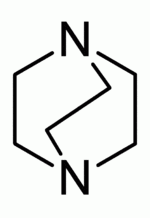Bicyclic molecule

undecane-3D-balls.png)


A bicyclic molecule (bi = two, cycle = ring) is a molecule that features two joined rings.[1] Bicyclic structures occur widely, for example in many biologically important molecules like α-thujene and camphor. A bicyclic compound can be carbocyclic (all of the ring atoms are carbons), or heterocyclic (the rings atoms consist of at least two different elements), like DABCO.[2] Moreover, the two rings can both be aliphatic (e.g. decalin and norbornane), or can be aromatic (e.g. naphthalene), or a combination of aliphatic and aromatic (e.g. tetralin).
There are three possible modes of ring junction for a bicyclic compound:[3]
- In spirocyclic compounds, the two rings share only one single atom, the spiro atom, which is usually a quaternary carbon.[4] An example of a spirocyclic compound is the photochromic switch spiropyran.
- In fused bicyclic compounds, two rings share two adjacent atoms. In other words, the rings share one covalent bond, i.e. the so-called bridgehead atoms are directly connected (e.g. α-thujene and decalin).
- In bridged bicyclic compounds, the two rings share three or more atoms, separating the two bridgehead atoms by a bridge containing at least one atom. For example, norbornane, also known as bicyclo[2.2.1]heptane, can be thought of as a pair of cyclopentane rings each sharing three of their five carbon atoms. The structure of camphor has the same basis as norbornane, but with some substituents added.
Nomenclature
Bicyclic molecules have a strict nomenclature.[5][6] The root of the compound name depends on the total number of atoms in all rings together, possibly followed by a suffix denoting the functional group with the highest priority. Numbering of the carbon chain always begins at one bridgehead atom (where the rings meet) and follows the carbon chain along the longest path, to the next bridgehead atom. Then numbering is continued along the second longest path and so on. Fused and bridged bicyclic compounds get the prefix bicyclo, whereas spirocyclic compounds get the prefix spiro. Inbetween the prefix and the suffix, a pair of brackets with numerals denotes the number of carbon atoms between each of the bridgehead atoms. These numbers are arranged in descending order and are separated by periods. For example, the carbon frame of norbornane (see picture) contains a total of 7 atoms, hence the root name heptane. This molecule has two paths of 2 carbon atoms and a third path of 1 carbon atom between the two bridgehead carbons, so the brackets are filled in descending order: [2.2.1]. Addition of the prefix bicyclo gives the total name bicyclo[2.2.1]heptane.
The carbon frame of camphor (see picture) also counts 7 atoms, but is substituted with a carbonyl in this case, hence the suffix heptanone. We start with numbering the carbon frame at the bridgehead atom with the highest priority (methyl goes before proton), hence the bridgehead carbon in front gets number 1, the carbonyl gets number 2 and numbering continues along the carbon chain following the longest path, until the doubly substituted top carbon (number 7). Equal to norbornane, this molecule also has two paths of 2 carbon atoms and one path of 1 carbon atom between the two bridgehead carbons, so the numbers within the brackets stay [2.2.1]. Combining the brackets and suffix (now filling in the position of the carbonyl as well) gives us [2.2.1]heptan-2-one. Besides bicyclo, the prefix should also specify the positions of all methyl substituents so the complete, official name becomes 1,7,7-trimethylbicyclo[2.2.1]heptan-2-one.
When naming simple fused bicyclic compounds, the same method as for bridged bicyclic compounds is applied, except the third path between the two bridgehead atoms now consists of zero atoms. Therefore fused bicyclic compounds have a "0" included in the brackets. For example, decalin is named bicyclo[4.4.0]decane.
The heterocyclic molecule DABCO (see picture) has a total of 8 atoms in its bridged structure, hence the root name octane. Note that here the two bridgehead atoms are nitrogen instead of carbon atoms. Therefore the official name gets the additional prefix 1,4-diaza and the total name becomes 1,4-diazabicyclo[2.2.2]octane.
Further reading
The following are principle sources for the developing content in this article, that contain further information that may be of interest to readers. In the books listed, the page numbers provided are for some of the chapters or sections of the book that cover spiro compounds.
- A high quality introductory to intermediate textbook of organic chemistry: Clayden, Jonathan; Greeves, Nick & Warren, Stuart (2012). Organic Chemistry (2nd ed.). Oxford, UK: Oxford University Press. pp. 319f, 432, 604np, 653, 746int, 803ketals, 839, 846f. ISBN 0199270295. Retrieved 2 February 2016.
- The IUPAC documents on naming of fused and bridged fused cyclic compounds: Moss, G.P.; The Working Party of the International Union of Pure and Applied Chemistry [IUPAC], Organic Chemistry Division, Commission on Nomenclature of Organic Chemistry (III.1) (1998). "Nomenclature of fused and bridged fused ring systems (IUPAC Recommendations 1998)" (PDF). Pure Appl. Chem. 70 (1): 143–216. doi:10.1351/pac199870010143. ISSN 1365-3075. Retrieved 7 March 2016. The full author (Working Party) list and a link to a German translation are provided in a corresponding footnote. Also available online at "Extension and Revision of the Nomenclature for Spiro Compounds". London, GBR: Queen Mary University of London., same access date.
References
- ↑ Michael. B. Smith, "Organic Chemistry: An Acid—Base Approach", Taylor & Francis, 2011, Page 302, https://books.google.nl/books?id=gKPtYs0jyMcC
- ↑ IUPAC Gold Book, heterocyclic compounds
- ↑ Thomas N. Sorrell, Organic Chemistry, University Science Books, 2006, Page 99, https://books.google.nl/books?id=txmp1aoCJp8C
- ↑ IUPAC Gold Book, spiro compounds
- ↑ Nomenclature of Organic Chemistry : IUPAC Recommendations and Preferred Names 2013 (Blue Book). Cambridge: Royal Society of Chemistry. 2014. pp. 155–157. doi:10.1039/9781849733069-FP001. ISBN 978-0-85404-182-4.
- ↑ Bridged Bicyclic Rings (And How To Name Them)